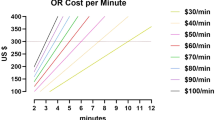Abstract
For this study, 66 patients with a preoperative diagnosis of unilateral primary inguinal hernia were randomized to undergo laparoscopic totally extra peritoneal (TEP), laparoscopic transabdominal (TAPP), or open inguinal hernia repair with polypropylene mesh (Lichtenstein type). Both the operative team caring for the patient postoperatively and the patient were blinded to the operative approach by placement of a large dressing covering the abdomen, which was not removed until postoperative day 3. The patients recorded their pain level on a visual analog pain scale daily. Medication usage also was recorded. All patients were seen at 7-day intervals until they returned to work. The patients were interviewed during their postoperative visits by an investigator blinded to the operative approach and questioned regarding their ability to return to work and their pain levels. The average number of lost work days in all the groups was 12, and there was no significant difference between the three groups (p = 0.074). The average operating time for the TAPP procedure was 59 min, less than the time required to complete either the TEP or the Lichtenstein approach, which had equivalent operative times (p = 0.027). The material cost was significantly lower for the Lichtenstein repair ($1,200 less) than for either of the laparoscopic approaches, a saving primarily related to consumable operating room supplies. The TEP repair costs were minimally higher than those for the TAPP repair ($125 more). No significant differences were noted in the postoperative pain scales, and the use of postoperative oral analgesics was equivalent. The higher operative costs noted for the laparoscopic hernia repairs were not offset by a shortened convalescence. Postoperative pain appears to be equivalent regardless of the operative approach chosen and is easily managed with oral analgesics.




Similar content being viewed by others
References
Ambach R, Weiss W, Sexton J, Russo A (2000) Back to work more quickly after an inguinal hernia repair. Military Med 165: 747–750
Arregui M, Navarrete J, Davis C, Castro D, Nagan R (1993) Laparoscopic inguinal herniorrhaphy: techniques and controversies. Surg Clin North Am 73: 513–527
Filipi C, Fitzgibbons R, Salerno G, Hart R (1992) Laparoscopic herniorrhaphy. Surg Clin North Am 72: 1109–1124
Grunwaldt LJ, Schwaitzberg SD, Rattner DW, Jones DB (2005) Is laparoscopic inguinal hernia repair an operation of the past? J Am Coll Surg 200: 616–620
Heikkinen Tk, Haukipuro K, Hulkko A (1998) A cost and outcome comparison between laparoscopic and Lichtenstein hernia operations in a day-case unit: a randomized prospective study. Surg Endosc 12: 1199–1203
Kald A, Anderberg B, Smedh K, Karlsson M (1997) Transperitoneal or totally extraperitoneal approach in laparoscopic hernia repair: results of 491 consecutive herniorrhaphies. Surg Laparosc Endosc 7: 86–89
Katz J, Melzack R (1999) Measurement of pain. Surg Clin North Am 79: 231–251
Leibl BJ, Jager C, Kraft B, Draft K, Schwarz J, Ulrich M, Bittner R (2005) Laparoscopic hernia repair: TAPP or/and TEP? Langenbecks Arch Surg 390: 77–82
Lepere M, Benchetrit S, Debaert M, Detruit B, Dufilho A, Gaujoux D, Lagoutte J, Saint Leon LM, Pavis d'Escurac X, Rico E, Sorrentino J, Therin M (2000) A multicentric comparison of transabdominal versus totally extraperitoneal laparoscopic hernia repair using PARIETEX meshes. JSLS 4: 147–153
Liem M, van der Graaf Y, Zwart R, Geurts I, van Vroonhoven T (1997) A randomized comparison of physical performance following laparoscopic and open inguinal hernia repair. The Coala Trial Group. Br J Surg 84: 64–67
Mcintosh E, Donaldson C, Grant A (1998) Economic evaluation of open versus laparoscopic hernia repair: some pragmatic considerations for the measurement of costs. Semin Laparosc Surg 5: 242–247
Neugerbauer E, Troidl H, Kum C, Eypasch E, Miserez M, Paul A (1995) The E.A.E.S Consensus Development Conferences on laparoscopic cholecystectomy, appendectomy, and hernia repair. Surg Endosc 9: 550–563
Neumayer L, Giobbie-Hunder A, Jonasson O, Fitzgibbons R Jr, Dunlop D, Gibbs J, Reda D, Henderson W (2004) Open mesh versus laparoscopic mesh repair of inguinal hernia. N Eng J Med 350: 1819–1827
Schrenk P, Woisetschlager R, Rieger R, Wayand W (1996) Prospective randomized trial comparing postoperative pain and return to physical activity after transabdominal preperitoneal, total preperitoneal, or Shouldice technique for inguinal hernia repair. Br J Surg 83: 1563–1566
Singhal T, Balakrishnan S, Paix A, El-Hasani S (2005) Early experience with laparoscopic inguinal hernia repair in a district general national health services hospital. J Laparoendosc Adv Surg Tech A 15: 285–289
The MRC Laparoscopic Groin Hernia Trial Group (1999) Laparoscopic versus open repair of groin hernia: a randomised comparison. Lancet 354: 185–190
Acknowledgments
This study was sponsored by the Chief, Navy Bureau of Medicine and Surgery, Washington, DC, Clinical Investigation Program (CIP #P01-0019). The views expressed in this article are those of the authors, and do not reflect the official policy or position of the Department of the Navy, the Department of Defense, or the United States Government.
Author information
Authors and Affiliations
Corresponding author
Rights and permissions
About this article
Cite this article
Butler, R.E., Burke, R., Schneider, J.J. et al. The economic impact of laparoscopic inguinal hernia repair: results of a double-blinded, prospective, randomized trial. Surg Endosc 21, 387–390 (2007). https://doi.org/10.1007/s00464-006-9123-6
Received:
Accepted:
Published:
Issue Date:
DOI: https://doi.org/10.1007/s00464-006-9123-6




